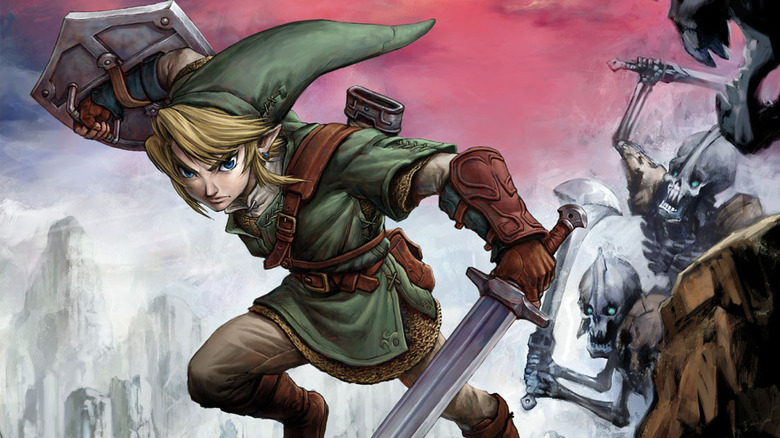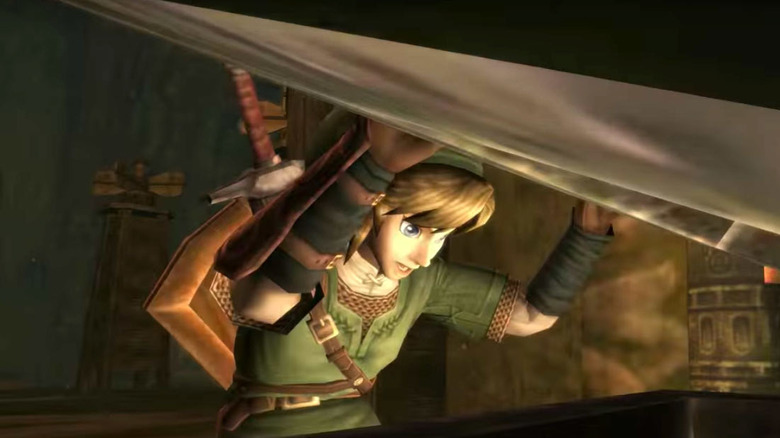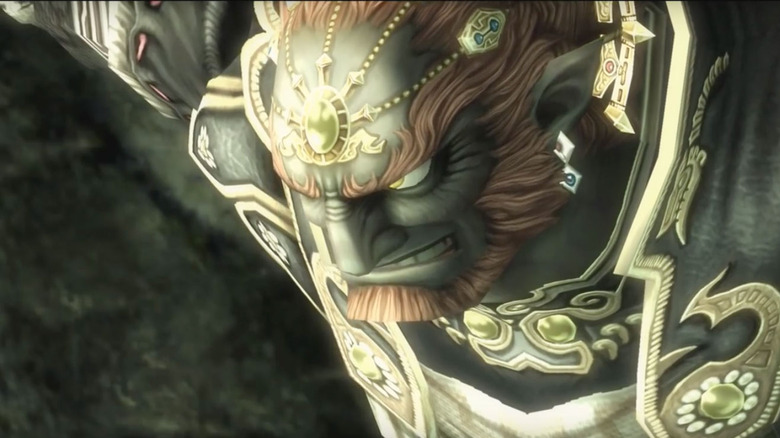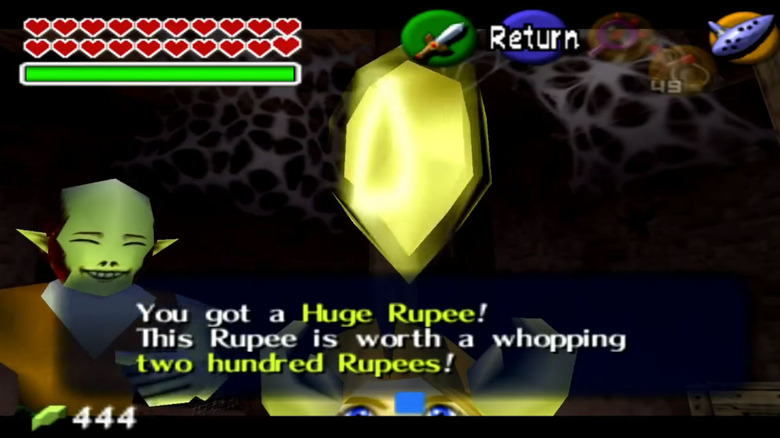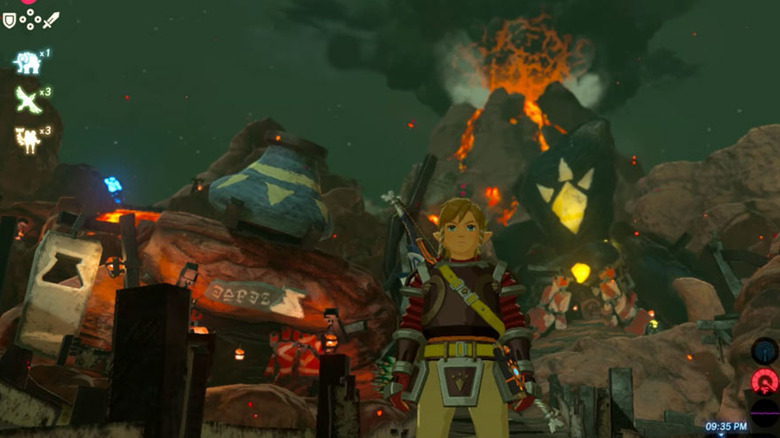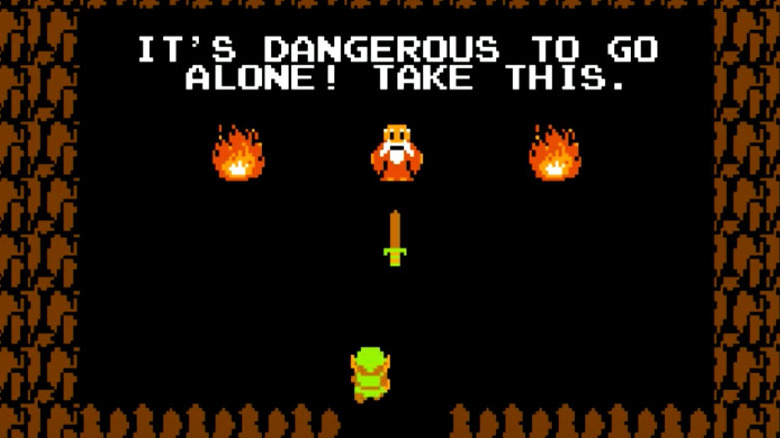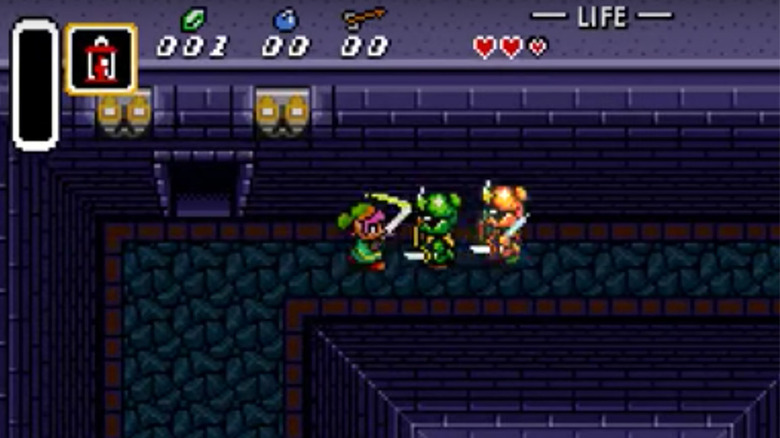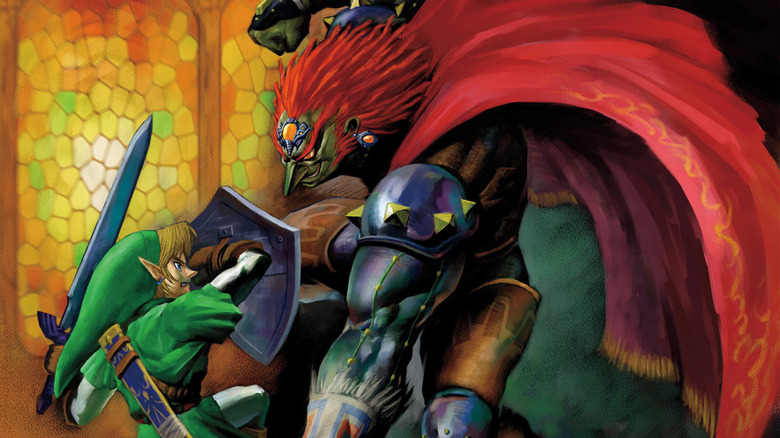Things In Zelda You Only Notice As An Adult
The Legend of Zelda is one of the most iconic video game franchises of all time, and it's easy to see why. From the moment it debuted in America on the Nintendo Entertainment System in 1987, the series has offered epic adventures with an unparalleled scope, full of secrets and new abilities that have given entire generations some pretty unrealistic expectations for how boomerangs work. In the years since, it's only grown bigger and far more complicated, with multiple timelines and universes, stories told out of chronological order, and, in one case, an entire game that was eventually revealed to be a dream of a giant fish.
Needless to say, there's a whole lot going on in these games that goes far beyond swinging the Master Sword and bombing walls, and some of it might've gone way over your head the first time you played the game. From a dodgy economy to an unexpected fetish, here's the stuff in The Legend of Zelda that you only notice as an adult.
Tomb raider
The usual path through a Zelda game takes you through a series of dungeons, each containing a particular weapon or item that you use to advance to the next dungeon. It's been going on for so long that it's more notable when the games break away from that pattern, but there's one thing that pattern has that, say, Mega Man's levels don't: they're not just dungeons, they're temples.
In other words, Link is a guy who wanders into an ancient holy site, smashes whatever he can, and promptly steals everything that isn't nailed down — Rupees, hookshots, boomerangs, and other ancient treasures — on his way to murdering whatever unique and endangered creature calls the place its home. And that's the best-case scenario. At worst, he's also going to flood the place, destroy huge chunks of the walls by blowing them up with bombs, and otherwise desecrate the entire temple.
The most charitable thing you can call him is a tomb raider, but in a very literal sense of the phrase, Link is a straight up grave robber, plain and simple.
The Master Sword is a tool of the oppressor
To say that the Zelda games portray Link as a hero is understating things by a pretty wide margin. He's not just a hero, he's the Hero — the Hero of Hyrule, the Hero of Time, the Hero of Legend, and so on. If you've got a noun, he's the hero of it. But is he really?
Most of that heroic reputation comes from the way he defeats Ganondorf and saves Princess Zelda, which is a all the explanation you need if you're playing the games as a kid. When you grow up and read, say, any history book ever, you hopefully realize that propping up an absolute monarchy isn't always the best course of action. At best, Link's maintaining the status quo, and as we can see from the games, that includes a kingdom where sentient non-human creatures like the Zora and the Gorons are segregated, maybe even confined, to their own kingdoms.
Ganondorf, on the other hand? That dude was born to a tribe of people who wandered the desert while the Hylians lived fat on the lush farmland of Hyrule, who clawed his way up from nothing, seized a third of an all-powerful magical force that had been kept hidden from the common man by the orders of the elite, and tried to overthrow a supposedly benevolent dictatorship. Face it, folks: that's basically Luke Skywalker, right down to the desert.
Breath of the Wild is Fallout with pointier ears
In 2017, Link's first outing on the Nintendo Switch topped plenty of "Game of the Year" lists, and for good reason. It reinvigorated the franchise, giving Link a huge, sprawling world to explore where the good guys had already lost. It was definitely a masterpiece, but if Breath of the Wild felt a little familiar to adult gamers, who can play more mature games, there's a good reason for that: it's basically just Fallout with swords.
Once you start noticing them, the similarities keep adding up. Both games are set decades after an apocalyptic cataclysm that left the world littered with advanced but broken-down technology that very few people understand. Like Fallout 4, Breath of the Wild involves the player character coming out of a cryogenic sleep, and like Fallout 3 and New Vegas, weapons degrade and break as you use them, leaving you to scrounge for new ones. The quest structure's the same, the Sheikah Slate bears a more-than-passing resemblance to Fallout's PIP-Boy, and the giant Hinox monsters feel a lot like Super Mutant Behemoths. Even the smaller elements like crafting, fast travel, and having a house to decorate feel lifted from Fallout.
But that's not actually a bad thing. Breath of the Wild takes the elements that made the Fallout games great and in a lot of cases, it arguably does them even better than the source material, making for an incredible new experience. Like the old saying goes, if you're going to steal, steal from the best.
The Great Fairies are absolutely fetish material
The Zelda games have always been a little weird about the Great Fairies, going all the way back to the angular, mostly naked versions that showed up in Ocarina of Time. With Breath of the Wild, though, they went all-in.
It's not the sort of thing you'd notice as a kid, and in fact, the sight of link recoiling from the over-the-top smooches of a giant woman who lives inside a huge flower would probably seem like hilarious slapstick more than anything else. If, however, you're playing that game as an adult whose time on the Internet has taught you all sorts of things that you didn't necessarily want to know, you know exactly what's going on. Those fairies aren't there for upgrades, they're absolutely there to satisfy someone's not-so-secret giantess fetish.
The giggles and moaning, Link's fruitless struggles against their inescapable but loving hugs, and the fact that they leave him spent and exhausted at the end of your transaction? Yeah, that's 100% a sex thing, and with the way he gets sucked under the surface of a toothy pond, there's even a little bit of vore — a fetish for being eaten alive that usually goes hand-in-hand, or at least body-in-mouth, with the whole giant woman thing — thrown in for good measure. Link even pays handsomely for the experience!
Not that we're judging. You have to respect the hustle of getting a giant woman kink to be such a prominent part of one of the biggest games of all time, and if nothing else, it adds a whole new selling point for a very specific audience.
Hyrule's economy makes no sense
Mario had his coins and Simon Belmont had money bags that were improbably hidden inside candlesticks, but the Zelda franchise was one of the first major video game franchises to introduce a fully functional economy. From the very first game, the shiny, irresistibly collectible Rupees weren't just there for bonus points: you could use them to buy weapons and power-ups. But nobody at Nintendo ever bothered to sit down and make the economy make sense.
It's pretty weird that most Hylians keep their money in ceramic pots that they leave unattended outside their houses, but on one level, that's easy to explain. Considering how often an evil army rolls through Hyrule, it's not like a bank would offer a whole lot of protection anyway. If, however, a heavily armed child in a green miniskirt rolled into our homes, shattered those jars by throwing them against the wall, scooped up the change, and left, we'd probably be a little upset about it. Not so for the people of Hyrule, who take this little bit of grand larceny in stride.
Maybe they're comforted by the fact that you can find Rupees pretty much everywhere. They even pop out of the ground when you cut grass — and that's even weirder than the whole ceramic bank situation. A currency so common that you can find a handful of them in the yard every time you go outside makes them effectively worthless. Forget about Ganon, the real danger to Hyrule is that they're about three weeks away from complete economic collapse.
Couldn't we call it Nice Flowers Mountain instead?
While Hyrule has taken many forms over the years, from the pastoral kingdom of Ocarina of Time to the broken wasteland of Breath of the Wild, but there's one piece of the landscape that remains consistent: Death Mountain, the ominous volcano that looms over Hyrule with a ring of clouds around its peak. It's intimidating, foreboding, threatening, and ... not that bad, actually.
Don't get it wrong, it's not exactly pleasant. At the very least, it's usually an active volcano, and it's often populated with stronger enemies, but you'll only find the end-of-the-game level bad guys there in the first Legend of Zelda. In most other games, it's just a place you pass through on the way to more dangerous territory, and more often than not, you'll find friendly allies there in the form of the Gorons. Either way, "Death Mountain" seems like a pretty dramatic name, but we suppose "Unpleasant Mountain" wouldn't look great on a map.
It's (extremely) dangerous to go alone
If you've ever played the original Legend of Zelda, then you already know that it has one of the most memorable openings that video games have ever seen. An old man in the darkness tells you that it's dangerous out there, and gives you ... a wooden sword. It's not much, but he's definitely right about the danger. In fact, traveling through the overworld, you're only going to encounter monsters. There are a few other human characters, but they're all huddling alone in caves.
As a kid, you probably wouldn't think there's anything weird about only encountering enemies, but think about it for a few seconds as an adult, and you can only come to one conclusion: Ganon and his army of monsters have killed everyone else in this sprawling section of Hyrule, leaving only Link, alone and armed with a stick, to stop him.
It becomes even more apparent if you pay attention to the overworld map of Zelda II. The fact that there's a section of the map representing the entirety of Zelda I tucked away at the southern tip of the Western continent is a pretty well-known piece of trivia, but consider this: unlike other areas of the map, this part doesn't have any towns, which likely means they were destroyed prior to the last game. The closest town still standing is separated from the carnage by a mountain range, and the other nearest landmark is a massive graveyard that's about as big as the first game's entire map.
End of the world? Nobody cares
For a series that's often marked by a kid-friendly appearance, the stakes in Zelda games are always high. At the very least, the fate of an entire kingdom is at stake, and usually the danger extends to the whole world, and even the timeline itself. So you'd think someone might want to actually help Link without demanding something in return, but it turns out they'd rather have a new chicken than, you know, be burned alive by an army of monsters.
It's bad enough that shopkeepers who are well-acquainted with the dire situation around them still make you pay for their wares, although Ravio from Link Between Worlds takes that to the next level. Even though the world is literally crumbling around him, he makes you rent weapons and items, and takes them back every time you die.
Still, Hyrule's ruthless devotion to capitalism is at least understandable. It's the fetch quests that really do it. The Biggoron Sword in Ocarina of Time famously requires you to go through a series of trades requiring ten different items to complete, but at least that one's optional. If you want to upgrade your sword in Oracle of Ages, however, get ready to play errand boy through a 13-step trading sequence that includes a random encounter. Link's Awakening is even worse, with 14 trades to get an item that's all but mandatory for making it to the end of your main quest.
The kicker? Usually, the item you want is something someone just has laying around, meaning that these nihilistic NPCs aren't even willing to give you their garbage to help save the world.
Link goes dark
In its massive, worlds-spanning quest, A Link to the Past features plenty of memorable monsters who fall before the might of the Master Sword, but your enemies in that game aren't just limited to moblins, lynels, and Dodongo. If you're paying attention to the earliest parts of the game, you'll know that Link might actually be the most prolific serial killer in the history of Hyrule.
Throughout his adventure across the Light World, Link often has to battle his way past armored soldiers, especially when he's rescuing Zelda from the castle in the opening. The thing is, it's revealed in dialogue that these guys aren't monsters: they're the actual knights of Hyrule Castle, who are being mind-controlled by Agahnim. In other words, they are themselves innocent victims of the evil wizard. The good news is that defeating Agahnim (and, eventually, Ganon) can free them from the curse and return them to their senses. The bad news? By the time you actually do that, you've straight up murdered a couple hundred of them.
Sure, it's easy to justify your actions when they're the ones who started it by throwing bombs at you, but it's still pretty dark to think of Link actually killing people instead of just monsters. If nothing else, wiping out the kingdom's entire army is only going to make Ganon's job easier next time.
Things might not be so bad if Ganon wins
Link's quest is built on one simple assumption: Ganon needs to be stopped. He is, after all, an incredibly powerful villain, and if he gets his hands on the Triforce, he'll destroy Hyrule and plunge the land into eternal darkness. Or will he?
See, as the name implies, the Triforce is divided into three aspects, and each one is embodied by one of the three main characters of the franchise. Link, of course, represents Courage, while Zelda has the Triforce of Wisdom. Ganon, as befitting the main boss of the games, is the embodiment of the Triforce of Power.
But what if Link and Zelda just gave him what he wants, and allow him to unite the Triforce himself? Power corrupts, and the Triforce is about as close to an absolute power as there is in the franchise, which explains Ganondorf's status as a ruthless, power-hungry warlord. If, however, he had the Wisdom to know how best to use that power, and the Courage that's necessary to put others before himself, he might actually turn out to be the best possible ruler. By standing in his way, you're the only thing preventing Hyrule from entering a true golden age.

